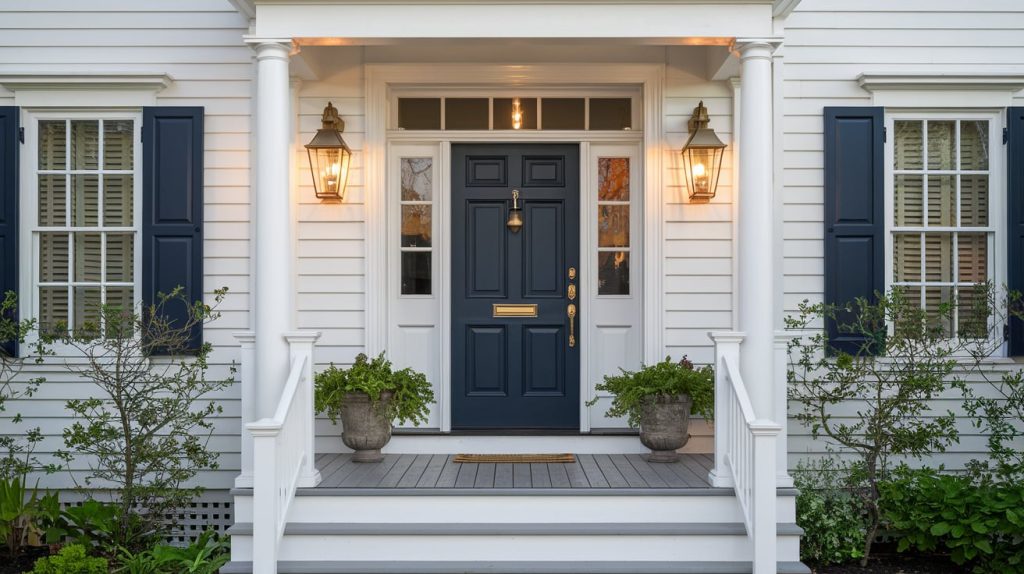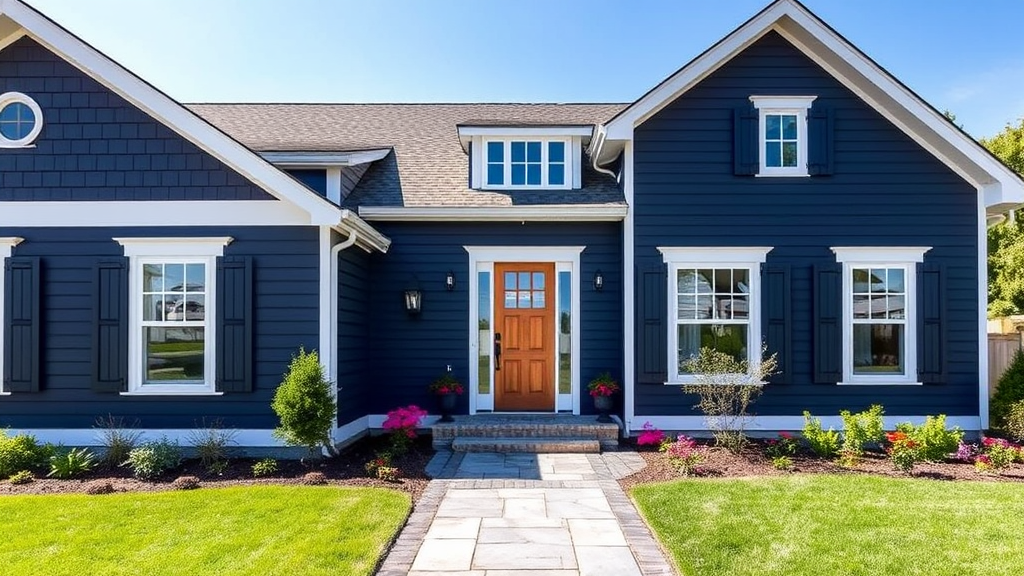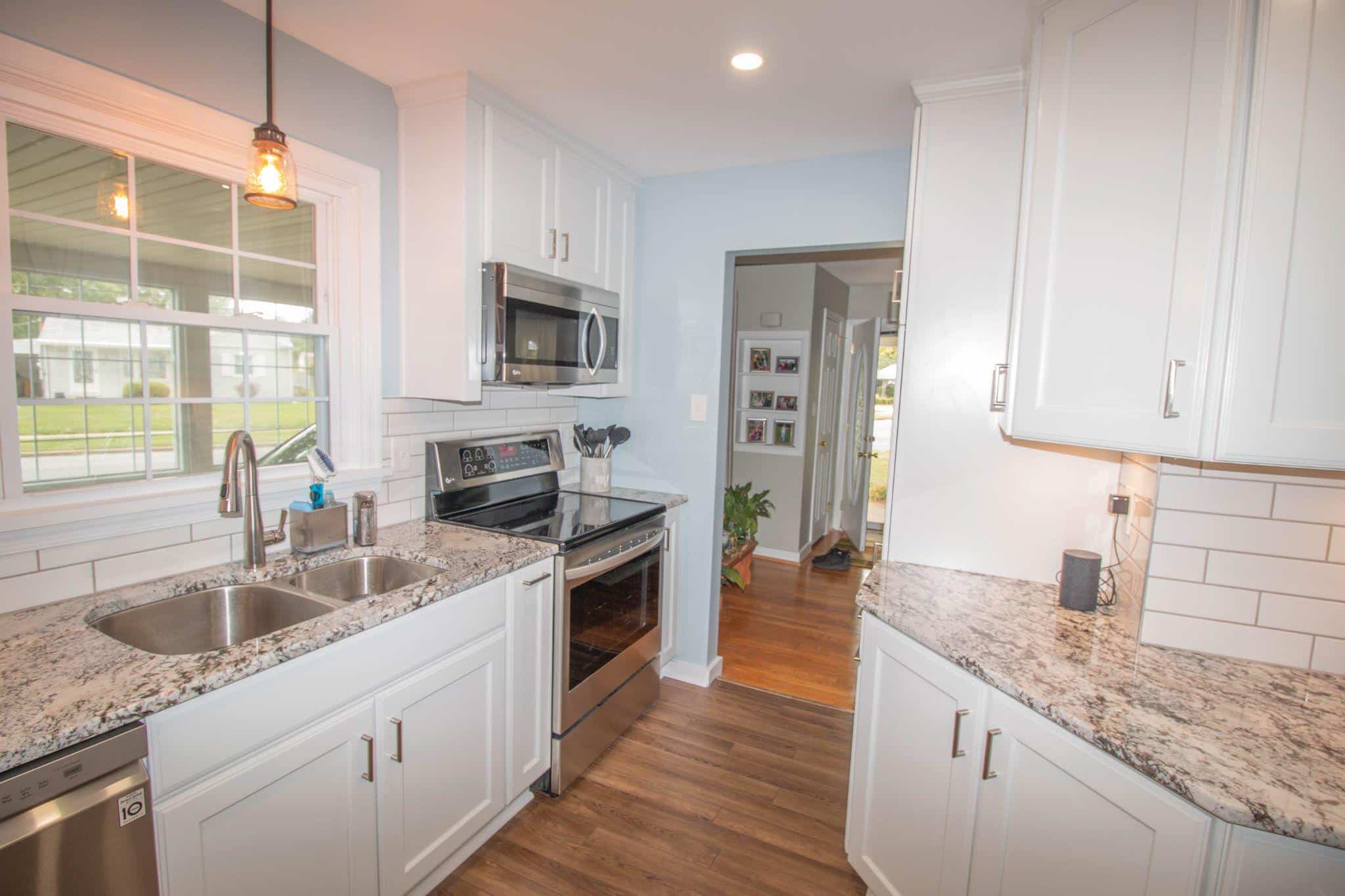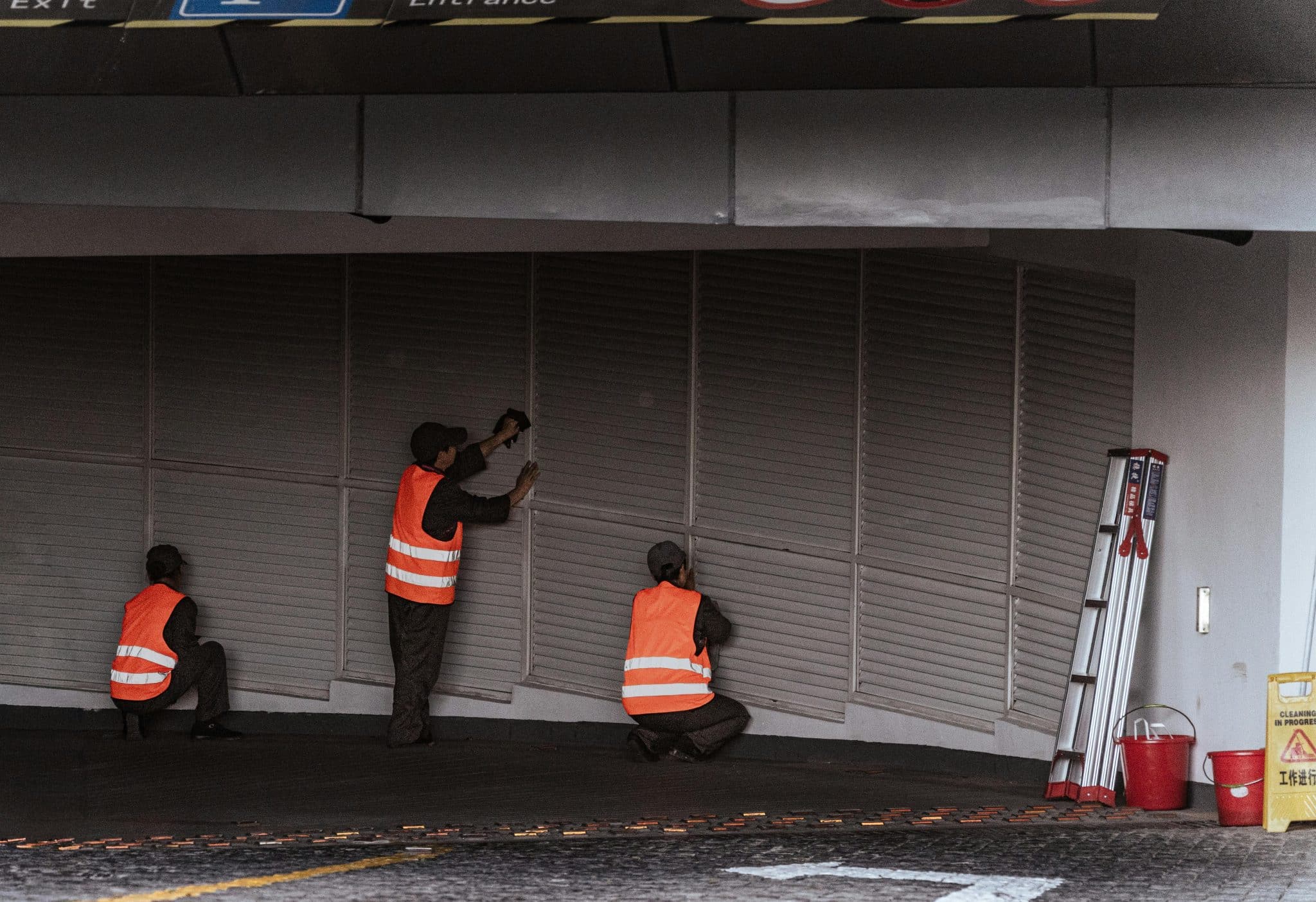Your house’s exterior paint affects how others perceive it. Benjamin Moore’s Hale Navy is a sophisticated choice among the countless blue shades available.
This rich, deep blue has captured the attention of homeowners and designers who want a classic look beyond basic neutrals.
The shade perfectly balances traditional appeal and modern style, making homes appear refined without being overwhelming.
When paired with white trim or natural materials, it creates striking contrasts that boost curb appeal.
Learn why Hale Navy remains a top pick for exterior paint colors and how this versatile shade can enhance your home’s appearance while maintaining its value over time.
What Makes Hale Navy Special?
1. The Perfect Balance of Depth and Richness
Hale Navy has a Very dark LRV of 8. This low LRV means it’s Well into the dark range. Hale Navy is absolutely positively blue with no obvious leaning towards violet or green.
Again, if you put it in, you should still see its ‘color’ as long as you have reasonable interior lighting. Benjamin Moore’s Hale Navy (HC-154) offers a distinctive blue tone that sets it apart from typical dark blues.
This shade has the right amount of black undertones to prevent it from appearing too bright or overpowering.
Unlike lighter blues that can fade into the background, this rich shade maintains its presence while still feeling welcoming and refined. The color’s depth creates a sense of stability and permanence that homeowners value.
2. How it Complements Various Architectural Styles
From Colonial and Cape Cod to Modern Farmhouse designs, Hale Navy proves itself as a flexible choice. On traditional homes, it highlights classic architectural details and trim work.
For contemporary structures, it provides a strong foundation that works well with modern materials like steel and glass. The shade’s versatility means it can serve as either a main exterior color or an accent for shutters and doors.
3. Its Adaptability to Different Lighting Conditions
One of Hale Navy’s strongest qualities is how it responds to changing light throughout the day. In the morning light, it appears crisp and defined. During midday sun, it holds its color without looking harsh or faded.
As evening approaches, the shade takes on deeper tones while maintaining its distinctive character. This consistent performance across various lighting conditions makes it a reliable choice for any home’s exterior.
Pairing Hale Navy with Other Colors
Hale Navy’s deep blue character makes it an excellent choice that complements many colors. The right combination of trim and accent colors can enhance your home’s exterior while maintaining its lasting appeal.
Best Trim Colors for Hale Navy
Selecting appropriate trim colors helps create a well-balanced exterior. Here are the top options that complement Hale Navy:
1. Crisp Whites
White trim creates a strong contrast that emphasizes Hale Navy’s rich depth. Benjamin Moore Chantilly Lace provides a bright, clean finish that stands out beautifully against the deep navy backdrop.
Sherwin-Williams Pure White offers a soft yet clear tone that creates the perfect definition for architectural details.
For those seeking additional warmth, Benjamin Moore Simply White brings a creamy quality that softens the contrast while maintaining visual interest.
2. Warm Neutrals
These gentle, warm shades add a welcoming feel to your exterior. Benjamin Moore Revere Pewter combines gray and beige tones for a sophisticated look that pairs perfectly with Hale Navy.
Sherwin-Williams Accessible Beige presents a light, warm touch that creates subtle distinction. Benjamin Moore Edgecomb Gray delivers a soft gray-beige blend that enhances the navy’s depth without competing for attention.
3. Soft Grays
Gray tones create refined combinations that feel polished. Benjamin Moore Stonington Gray brings a cool, fresh look that complements the navy’s intensity.
Sherwin-Williams Light French Gray maintains a neutral balance that works across different lighting conditions. Benjamin Moore Classic Gray adds a light, warm touch that creates subtle sophistication in the overall color scheme.
Accent Options that Enhance Hale Navy’s Appeal
Well-chosen accents can add personality and depth to a Hale Navy exterior, making your home stand out while maintaining its sophisticated appearance.
1. Wood Tones
Natural wood elements bring warmth and character to Hale Navy exteriors. A solid wooden door in rich mahogany creates an inviting entrance, while cedar shutters offer traditional charm.
Walnut-stained porch details provide subtle richness, and driftwood finishes add a casual, coastal feel.
These natural materials create a stunning partnership with the deep blue shade, offering texture and visual interest that changes throughout the day as light shifts.
2. Metallic Finishes
Through carefully selected hardware and fixtures, metal accents can define your home’s style. Brass and gold tones provide warm, luxurious touches that shine against the deep blue background.
Matte black hardware creates clear, modern lines that strengthen the overall design.
Brushed nickel or chrome fixtures offer a clean, contemporary feel while maintaining the home’s refined appearance. These metal finishes work particularly well on door handles, light fixtures, and mail slots.
3. Bold Hues
Strategic use of bright colors can make your home memorable while maintaining its refined character. A mustard yellow front door creates a welcoming focal point that naturally draws attention.
Deep red or burgundy accents bring a sense of tradition and sophistication to the exterior.
For those seeking something different yet refined, emerald green or teal touches can create an eye-catching combination that still feels grounded and intentional.
Hale Navy in Different Exterior Applications
Understanding how to use Hale Navy in various exterior elements can help you make informed decisions about your home’s appearance. Let’s examine the most effective ways to incorporate this versatile shade.
1. Using Hale Navy as Siding and Main Exterior Color
When used as the primary exterior color, Hale Navy creates a strong presence that maintains its appeal across seasons. On traditional siding, the color provides depth without feeling heavy, while on modern surfaces, it offers a contemporary feel.
The shade performs exceptionally well on different materials, from fiber cement to wood siding, maintaining its rich appearance.
This color stands out while remaining tasteful, making it a reliable choice for main exterior walls in neighborhoods with varied home styles. Its consistent performance in different lighting conditions makes it a good choice for these walls.
2. Making a Statement with Hale Navy Front Doors and Shutters

Using Hale Navy on front doors and shutters offers a measured way to introduce this distinguished color to your home’s exterior.
On a light-colored house, a Hale Navy front door serves as a striking centerpiece that welcomes guests with understated sophistication. Shutters in this shade add structure and definition to windows, creating beautiful symmetry.
The color’s depth makes architectural details more noticeable without appearing flashy. This application works especially well with traditional home styles and creates lasting curb appeal.
3. Using Hale Navy on Garage Doors and Outdoor Features
On garage doors, Hale Navy reduces the visual impact of this often prominent feature while adding interest. The color helps blend the garage door with the overall design of your home while maintaining visual appeal.
Its deep tone creates subtle shadows and highlights that add dimension to flat surfaces.
When paired with matching trim or contrasting hardware, Hale Navy garage doors become an asset to your home’s exterior design rather than just a functional necessity.
4. Enhancing Porches with Hale Navy
Porch ceilings painted in Hale Navy create a subtle surprise element that draws the eye upward. This application brings an unexpected touch of sophistication to outdoor living spaces.
The shade works well with both natural wood decking and painted porch floors, offering versatility in design choices. The color creates a cozy atmosphere for outdoor seating areas and adds depth to covered spaces.
White ceiling fans or light fixtures stand out beautifully against this rich background.
5. Outdoor Furniture in Hale Navy
This shade provides a practical yet refined option for outdoor furniture. It conceals wear while maintaining its distinguished appearance.
Patio chairs, benches, and tables in Hale Navy create cohesive outdoor spaces that complement your home’s exterior. The color withstands outdoor conditions well and provides a timeless look.
It pairs particularly well with neutral cushions and outdoor accessories. You can change accent colors seasonally while maintaining a stable base design.
The Psychological Impact of Navy Blue
People naturally respond to navy blue in ways that make it perfect for home exteriors. This deep shade brings calm and order to any setting.
Studies show that navy blue often reminds people of trustworthy institutions and lasting quality. When used on homes, this color sends signals of reliability and good taste.
The shade’s natural connection to sky and sea tones helps it feel grounded and familiar, making it a popular color choice.
Navy blue consistently ranks among the top exterior colors for maintaining home value.
Real estate professionals note that houses with navy blue exteriors often photograph well for listings and create strong first impressions during viewings. The color’s broad appeal means it rarely turns away potential buyers.
Home appraisers have found that well-maintained navy blue exteriors can contribute positively to a property’s market position, especially when combined with crisp white trim and polished accents.
Maintenance Tips for Hale Navy Exteriors
- Wash surfaces twice yearly using a mild soap solution and a soft-bristled brush to keep the color looking fresh.
- Check for signs of peeling or fading bi-annually, especially on south-facing walls that receive more sun exposure.
- Clean gutters regularly, as water overflow can leave marks on Hale Navy surfaces.
- Remove dust and cobwebs monthly from door frames and window sills to maintain a crisp contrast with trim.
- Touch up small chips or scratches promptly to prevent moisture from getting under the paint.
- Use a soft cloth for regular dusting of Hale Navy doors and shutters to maintain their rich appearance.
- Inspect caulking around windows and doors annually to prevent water damage that could affect the paint.
- Consider repainting every 5-7 years to maintain the color’s depth and protect your home’s exterior.
- Keep trees and bushes trimmed away from painted surfaces to prevent scratching and organic buildup.
- Use a pressure washer on the lowest setting when cleaning, as high pressure can damage the paint finish.
Conclusion
Benjamin Moore’s Hale Navy is a trusted choice for exterior home design. This deep blue shade offers lasting beauty that complements both modern and traditional homes.
Its flexibility shows in its many uses – from grand main exteriors to subtle accents on doors and shutters. The color maintains its rich look across different lighting conditions and seasons.
When paired with crisp whites, warm neutrals, or soft grays, Hale Navy creates a refined appearance that draws admiring glances. Its timeless nature means your home will look sophisticated for years to come.
The color’s practical benefits—from simple maintenance to enduring market appeal—make it a wise choice for homeowners who want both beauty and value.
Properly maintained, Hale Navy offers a classic exterior option that continues to impress.


















